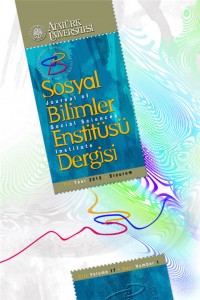A Plotinian Reading of Virginia Woolf’s to the Lighthouse / Virginia Woolf’un Deniz Feneri Adlı Romanına Plotinus Felsefesi Işığında Bir Bakış
Abstract
Keywords
References
- Bryson, Michael (2013) “Plotinus--On the Intellectual Beauty”. http://www.brysons.net/ academic/plotinus.html
- Fennelly, Kristina (2004). “To the lighthouse, to the self “. Theses and Dissertations. Paper 848. Print.
- Fry, Roger (1965). Vision and Design. Cleveland: The World Publishing Company. Print.
- Koppen, Randi (2001). “Embodied Form: Art and Life in Virginia Woolf’s ‘To the Lighthouse’”. New Literary History. Vol. 32.2. The Johns Hopkins U.P. Print. Leaska, Mitchell A (1970). Virginia Woolf’s To the Lighthouse. London: The Hogarth Press.
- Pedersen, Glenn (1958). “Vision in to the Lighthouse”. PMLA. Vol.73.5. Modern Language Association. Print.
- Plotinus (2013) Enneads. Trans. Stephen Mackenna, B.S.Page. http://classics.mit.edu/ Plotinus/enneads.html
- Schneider, Daniel J. (1984). “To the Lighthouse”, PMLA. Vol. 99.5. Modern Language Association Print.
- Wallis, R.T. (1995). Neoplatonism. Indianapolis:Hackett Pub. Print.
- Woolf, Virginia (2002). To the Lighthouse. Hertfordshire: Wordsworth Editions.
Abstract
Virginia Woolf modernist İngiliz romancılığının öncülerinden biri ve bilinçakışı
tekniğinin önde gelen isimlerindendir. Başyapıtlarından biri olan Deniz Feneri adlı
romanı, temelde Woolf’un edebî tekniğini ve 20. Yüzyılın başındaki bir kadın yazar
olarak hayat görüşünü yansıtır. Woolf’un romandaki üç başkarakterini, Bayan Ramsay,
Bay Ramsay ve Lily Briscoe, tasviri okuyucuya bireysel, estetik ve entelektüel düzeyde
arzuların tatmini portresi sunar.
Bayan Ramsay’in doğada ve ev içi ilişkilerdeki uyum arayışı ve tanrının yaratıları
arasındaki arabulucu rolü, Plotinus’un tanrıya ulaşma konusundaki tefekkür felsefesi ile
ilişkilendirilebilir. Bu bağlamda, bu makalede, Woolf’un Deniz Feneri eserindeki Bayan
Ramsay karakteri Plotinus’un sözü geçen felsefesi ışığında incelenecektir.
References
- Bryson, Michael (2013) “Plotinus--On the Intellectual Beauty”. http://www.brysons.net/ academic/plotinus.html
- Fennelly, Kristina (2004). “To the lighthouse, to the self “. Theses and Dissertations. Paper 848. Print.
- Fry, Roger (1965). Vision and Design. Cleveland: The World Publishing Company. Print.
- Koppen, Randi (2001). “Embodied Form: Art and Life in Virginia Woolf’s ‘To the Lighthouse’”. New Literary History. Vol. 32.2. The Johns Hopkins U.P. Print. Leaska, Mitchell A (1970). Virginia Woolf’s To the Lighthouse. London: The Hogarth Press.
- Pedersen, Glenn (1958). “Vision in to the Lighthouse”. PMLA. Vol.73.5. Modern Language Association. Print.
- Plotinus (2013) Enneads. Trans. Stephen Mackenna, B.S.Page. http://classics.mit.edu/ Plotinus/enneads.html
- Schneider, Daniel J. (1984). “To the Lighthouse”, PMLA. Vol. 99.5. Modern Language Association Print.
- Wallis, R.T. (1995). Neoplatonism. Indianapolis:Hackett Pub. Print.
- Woolf, Virginia (2002). To the Lighthouse. Hertfordshire: Wordsworth Editions.
Details
| Primary Language | en;tr |
|---|---|
| Journal Section | Makaleler |
| Authors | |
| Publication Date | June 18, 2013 |
| Published in Issue | Year 2013 Volume: 17 Issue: 1 |



